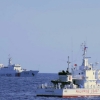Europe’s Crisis: A Hard Landing for China?
The success of China’s economy has stolen the world’s attention with spectacular double digit growth in three decades. As Asian country that remains holding communist socialist concept, China has successfully implemented market economy which is liberal-economy’s identity. Joining World Trade Organization in 2001, China has extended their trade activity and transformed to be more integrated with world’s economy.
China’s economy slowdown due to European sovereign debt and tight monetary policy urged China government to decrease its economic growth target to 7.5% in 2012. It raises concern of hard landing in China. This concern could be identified by China’s growth in Q1-2012 grew by 8.1% YoY, significantly slower than Q4-2011 at growth level of 8.9% YoY. This slowdown is most likely caused by weakening domestic and foreign demand, investment and declining exports.
Sovereign debt crisis affects China’s economy on both financial and trade market. In financial market, European crisis could influence stock and bond prices by contagion effects due to capital outflow and deleveraging from European countries. In international trade side, the China slowdown is triggered by decelerating export to Europe due to effects of fiscal consolidation and Euro depreciation. The combination of fiscal consolidation and Euro depreciation leads to a decrease in export exposures of China and other emerging countries to Europe.
On trade sector, worsening Europe economy condition and not-fully-recovered US economy also affected a decrease in China’s export which has been contracted in Q1-2011 and Q1-2012. Thanks to Hong Kong, ASEAN, Japan and other emerging countries that still imported from China. Meanwhile, the export exposures to European and US are getting decreasing. In 2008 US crisis has encouraged China to shift their export’s country destination to Asia. Being absorbed by Asian market, China’s export is still supported by positive growth in Asia and improving inter-Asia trade as implementation of China ASEAN Free Trade Agreement (CAFTA) in 2009.
The Effects of China’s economic slowdown to Indonesia.
China’s power has driven export which generates foreign reserves of USD 1.3 tn, the biggest in the world. However, China’s export performance has been weakening since January 2012 which the export growth was exceeded by import growth. This declining performance continues in February 2012, for the first time since last 2 decades China’s trade deficit has reached its lowest at USD 31.6 bio. This mainly caused by declining European’s demand.
This China’s deteriorating trade performance becomes a rational reason to revise down its economic growth projection. Moreover, China has devaluated its currency by 8.7% to 6.2875 per USD compared to last 2 years. China implements a controlled floating exchange rate system with range ±0.5% of mean of the exchange rate. Looking at China’s export-import in last 2 months, we must be aware of implications of these China’s declining trade especially to Indonesia’s export.
In China-Asian Free Trade Agreement(C-AFTA) development in last 2 years, export-import performance of Indonesia has been increasing significantly. Exports grew by 35.5% YoY in 2010 and by 28.9% in 2011, meanwhile import also grew faster by 40.1% YoY in 2010 and by 30.8% in 2011. However, trade balance is still positive, with decreasing surplus. With weakening demand from EU, Indonesia becomes China’s market target both low-end and high-end consumer goods. Moreover, at the same time, Indonesia’s GDP per capita keeps increasing followed by increasing number of medium-high level people.
In export side, China’s slowdown becomes direct thread for Indonesia’s export. China is one of major export destination countries for commodity and mineral products. Coal and crude palm oil exports would be threatened by China’s weakening demand. China, the third biggest after India and EU for CPO export reached 20% of total CPO exports. Meanwhile, coal export to China is approximately ranging 24% of total coal exports. Since January 2012, export of those two commodities has been declining as decreasing China’s export. Moreover in last 5 months, export recorded monthly negative growth.
Going forward, China’s economy slowdown is expected to be temporary and recovering soon, as well as Indonesia’s export. Furthermore, government is expected to extend export destination countries so that export is not dependent of existing countries. Government policy that urges shifting from up-stream to down-stream industry is highly needed for example requirement of smelter development in factory in order to create value-added. Export competency in Asian region should be improved with any efficiency effort reducing high cost economy. In import side, government is expected to manage and protect domestic market amid C-AFTA un-flexibility. In the future, it is expected that domestic product could ‘compete’ with low-cost imported products which eventually strengthen and promote economic growth.
This paper is a personal opinion from Josua Pardede, Economist of PT BNI Securities.








